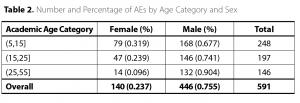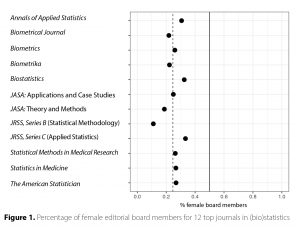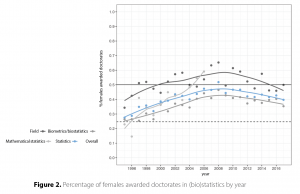Study Reveals Gender Imbalance on (Bio)statistics Editorial Boards
Andrea Foulkes, MGH Research Institute
Editor’s note: Click on the tables and figures to enlarge.
 The results of a recent study reveal an apparent discrepancy in the numbers of males and females who serve on editorial boards of prestigious biostatistics and statistics journals. The overall proportion of females awarded doctorates in the United States has been consistently above 40% for the past 17 years. Yet, the overall proportion of female associate editors (AEs) for 12 top journals in statistics and biostatistics is just 24.6%.
The results of a recent study reveal an apparent discrepancy in the numbers of males and females who serve on editorial boards of prestigious biostatistics and statistics journals. The overall proportion of females awarded doctorates in the United States has been consistently above 40% for the past 17 years. Yet, the overall proportion of female associate editors (AEs) for 12 top journals in statistics and biostatistics is just 24.6%.
 The study, conducted by Andrea Foulkes, director of the biostatistics center in the division of clinical research at MGH Research Institute, was spurred by the fact that editorial boards of scientific journals are among the most influential bodies in the academy, as they collectively make critical decisions about the dissemination of research findings to the larger community. Members of these boards play a vital role in identifying referees and soliciting reports, evaluating the nuances and relative contributions of these reports, and ultimately discerning the suitability of manuscripts for publication. At the same time, membership to an editorial board is considered a significant milestone with respect to criteria for promotion at academic institutions, particularly from the rank of associate to full professor.
The study, conducted by Andrea Foulkes, director of the biostatistics center in the division of clinical research at MGH Research Institute, was spurred by the fact that editorial boards of scientific journals are among the most influential bodies in the academy, as they collectively make critical decisions about the dissemination of research findings to the larger community. Members of these boards play a vital role in identifying referees and soliciting reports, evaluating the nuances and relative contributions of these reports, and ultimately discerning the suitability of manuscripts for publication. At the same time, membership to an editorial board is considered a significant milestone with respect to criteria for promotion at academic institutions, particularly from the rank of associate to full professor.
To begin this investigation, Foulkes—along with Mount Holyoke alumni Rachel Bostick, Regina Brecha, and Savannah Romeo—downloaded a listing of editorial board members for each of 12 top journals in statistics and biostatistics. While not comprehensive, these journals are representative in scope, ranging from novel statistical applications to statistical theory. The journal names and corresponding numbers of associate editors (AEs) are provided in Table 1. Sex was recorded as a binary variable based on visual assessments of online images or indicated pronouns. A sex determination was made in 633 of 642 cases (98.6% of AEs), and the impact of potential misclassification is expected to be small. For each journal, the proportion of female AEs was recorded. There was overlap in editorial board members across journals, so the reported proportions are not independent.
To contextualize the results of this study, Foulkes also considered: (1) the distribution of academic age of AEs, defined as the number of years since receiving a doctoral level degree, and (2) the percentages of female doctoral degree recipients in the United States by discipline (biometrics/biostatistics, mathematical statistics, or statistics) from 1995 to 2017. Academic age data was collected from self-reported online resources (e.g., personal webpages and LinkedIn), and age is missing for 42 of 642 cases (6.5% of AEs.) The numbers of earned doctorates by discipline and year were taken from the National Science Foundation’s National Center for Science and Engineering Statistics (NCSES) Survey of Earned Doctorates.
 The proportions of female editorial board members by journal are provided in Figure 1. The percentage of female board members for all journals combined is 24.6%, represented by the dotted vertical line in Figure 1. The range across the 12 considered journals is 0.11 to 0.33. The solid vertical line in this figure corresponds to an equal proportion of male and female board members. The median and interquartile range of academic age by journal is given in Table 1. The sample correlation between median academic age and percentage of female AEs is -0.23 [95% confidence interval (-0.71, 0.39)]. The numbers and percentages of AEs in each of three age categories by sex are provided in Table 2.
The proportions of female editorial board members by journal are provided in Figure 1. The percentage of female board members for all journals combined is 24.6%, represented by the dotted vertical line in Figure 1. The range across the 12 considered journals is 0.11 to 0.33. The solid vertical line in this figure corresponds to an equal proportion of male and female board members. The median and interquartile range of academic age by journal is given in Table 1. The sample correlation between median academic age and percentage of female AEs is -0.23 [95% confidence interval (-0.71, 0.39)]. The numbers and percentages of AEs in each of three age categories by sex are provided in Table 2.
 The percentages of women receiving doctoral degrees in biostatistics/biometrics, mathematical statistics, and statistics in the United States from 1995 to 2017 are illustrated in Figure 2. The statistics designation is available up to and including 2006. The fitted lines in this figure are based on locally estimated scatterplot smoothing (LOESS) overall and for each of the corresponding degree classifications. The dotted horizontal line represents the present-day percent of female AEs, and the solid horizontal line corresponds to an equal proportion of males and females. Since 1995, 5,494 individuals—including 2,228 women—earned a doctorate in biostatistics/biometrics, mathematical statistics, or statistics in the United States more than 10 years ago.
The percentages of women receiving doctoral degrees in biostatistics/biometrics, mathematical statistics, and statistics in the United States from 1995 to 2017 are illustrated in Figure 2. The statistics designation is available up to and including 2006. The fitted lines in this figure are based on locally estimated scatterplot smoothing (LOESS) overall and for each of the corresponding degree classifications. The dotted horizontal line represents the present-day percent of female AEs, and the solid horizontal line corresponds to an equal proportion of males and females. Since 1995, 5,494 individuals—including 2,228 women—earned a doctorate in biostatistics/biometrics, mathematical statistics, or statistics in the United States more than 10 years ago.
The overall proportion of females awarded doctorates in the United States has been consistently above 40% for the past 17 years. Moreover, in biometrics/biostatistics, this proportion has exceeded 50% in the majority of years since 1997, reaching a peak of 65.3% in 2008. Yet, the overall proportion of female AEs for the 12 considered journals is just 24.6%. This proportion is higher at 31.9% in the 5−15-year academic age category, though still not reflective of the proportion of females awarded doctorates in the corresponding period in the United States. Finally, although there is some variability in the proportion of female AEs across journals, the interquartile range (IQR) is fairly narrow at 0.221 to 0.278, and the female board membership is consistently less than 50%.
Editorial board membership requires substantial expertise in one or more areas of statistics and a broad network of colleagues from whom one can solicit referee reports. While it is difficult to quantify these attributes, academic age may serve as a reasonable surrogate. One limitation of this study is that Foulkes only considers doctorates awarded in the United States, while the proportion of females awarded doctorates outside the United States may be lower and editorial boards are composed of international scholars. In addition, Foulkes does not consider whether the proportion of doctorates awarded to women differ by rank of institution. However, she thinks the large number of females who earned doctorates more than 10 years ago, and the relatively high proportion in the United States, provides a significant opportunity to create parity in the editorial decision-making process. Rather than allowing editorial board membership to reflect a legacy of discrimination, Foulkes urges the leadership of scientific journals in (bio)statistics to take an active role in balancing the sex ratio of board membership by inviting more women to serve in this role.

















